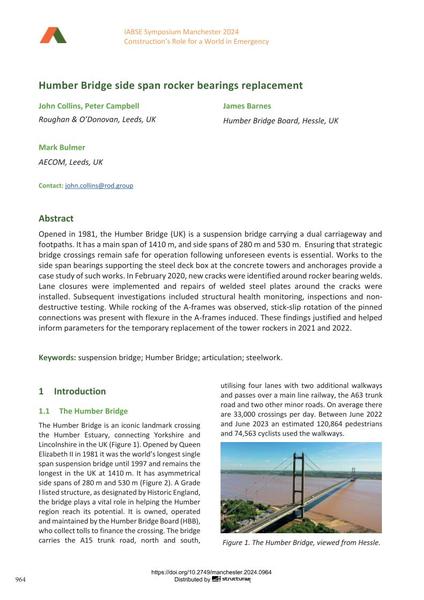Humber Bridge side span rocker bearings replacement

|
|
|||||||||||
Détails bibliographiques
| Auteur(s): |
John Collins
(Roughan & O’Donovan, Leeds, UK)
Peter Campbell (Roughan & O’Donovan, Leeds, UK) James Barnes (Humber Bridge Board, Hessle, UK) Mark Bulmer (AECOM, Leeds, UK) |
||||
|---|---|---|---|---|---|
| Médium: | papier de conférence | ||||
| Langue(s): | anglais | ||||
| Conférence: | IABSE Symposium: Construction’s Role for a World in Emergency, Manchester, United Kingdom, 10-14 April 2024 | ||||
| Publié dans: | IABSE Symposium Manchester 2024 | ||||
|
|||||
| Page(s): | 964-971 | ||||
| Nombre total de pages (du PDF): | 8 | ||||
| DOI: | 10.2749/manchester.2024.0964 | ||||
| Abstrait: |
Opened in 1981, the Humber Bridge (UK) is a suspension bridge carrying a dual carriageway and footpaths. It has a main span of 1410 m, and side spans of 280 m and 530 m. Ensuring that strategic bridge crossings remain safe for operation following unforeseen events is essential. Works to the side span bearings supporting the steel deck box at the concrete towers and anchorages provide a case study of such works. In February 2020, new cracks were identified around rocker bearing welds. Lane closures were implemented and repairs of welded steel plates around the cracks were installed. Subsequent investigations included structural health monitoring, inspections and non- destructive testing. While rocking of the A-frames was observed, stick-slip rotation of the pinned connections was present with flexure in the A-frames induced. These findings justified and helped inform parameters for the temporary replacement of the tower rockers in 2021 and 2022. |
||||
| Mots-clé: |
pont suspendu
|
||||
